6 day birding trip – July-August 2022
This personalized birding tour was designed with the purpose of getting most of the Yucatan Peninsula endemics while also trying to get as many bird species as possible.
Our birding trip started in Mérida, where I picked up Daniel and did a short drive to start looking for some birds in the scrubs and dry forest north of the Yucatan state. Weather was nice, birds were singing and we kicked off with some really cool species like: Black-throated Bobwhite, Yellow-billed Cuckoo, Lesser Nighthawk, Cinnamon Hummingbird, Gray Hawk, Turquoise-browed Motmot, Rose-throated Becard, Mangrove Vireo, Yucatan Jay, Yucatan Gnatcatcher, Carolina (White-browed Wren), Orange Oriole, Gray-crowned Yellowthroat, Black-headed Trogon, Yucatan Woodpecker and Gray-throated Chat.
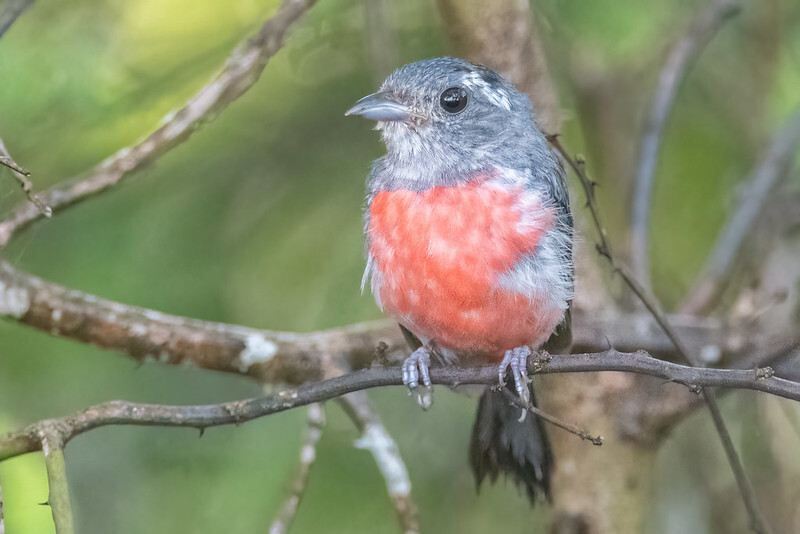
Gray-throated Chat (Granatellus sallaei) by Daniel J. Field.
After a great first stop, we went to the coast to look for two very special birds the Mexican Sheartail and the Yucatan Wren, two endangered Yucatan endemics which you can only see in the Northern Coast of the Peninsula.
While those two were our main targets, we also saw some other nice birds, including: American Flamingo, Common Ground Dove, Groove-billed Ani, Wilson’s Plover, Semipalmated Plover, Snowy Plover, Semipalmated Sandpiper, Western Sandpiper, Wood Stork, Reddish Egret, Magnificent Frigatebird, Common Tody-Flycatcher, Mangrove Swallow, Cave Swallow, Hooded Oriole, Northern Cardinal and Mangrove Warbler.
Weather was getting really hot, so we went back to Mérida for lunch and a break and went back birding in the afternoon, once again to the coast but now to a different area. Highlights from the afternoon include: Clapper Rail, Ruddy Crake, Stilt Sandpiper, Least Tern, Gull-billed Tern, Roseate Spoonbill, Green Kingfisher, Ladder-backed Woodpecker, Vermilion Flycatcher, Purple Martin, Yellow-tailed Oriole, Morelet’s Seedeater and Cinnamon-bellied Saltator.
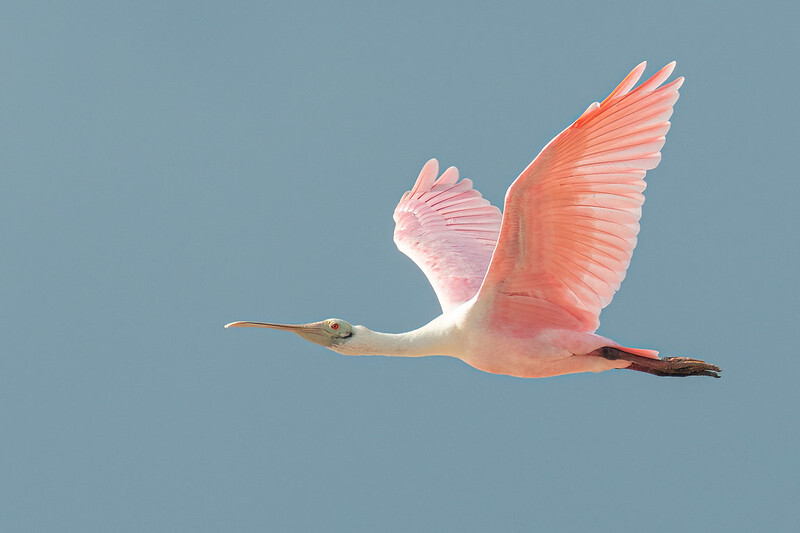
Roseate Spoonbill (Platalea ajaja) by Daniel J. Field.
We went back to Mérida really happy after having seen such special birds, we had dinner, actually watched a baseball game while at it and then, to rest for our next day.
For the second day of the trip, we headed southeast to the humid forests of the Yucatan state, where we visited an area that combines crops and the edge of the forest which actually makes a good combo if you’re trying to see parrots in flight and some birds going for the free meal.
Highlights included: Plain Chachalaca, Squirrel Cuckoo, Canivet’s Emerald, White-bellied Emerald, Gartered Trogon, Lineated Woodpecker, Olive-throated Parakeet, Olivaceus Woodcreeper, Ivory-billed Woodcreeper, Gray-collared Becard, Northern Bentbill, Yellow-olive Flycatcher, Bright-rumped Attila, Brown Jay, Spot-breasted Wren, Yellow-backed Oriole, Rose-throated Tanager, Red-throated Ant-Tanager, Blue Bunting, Black-headed Saltator.
Gartered Trogon (Trogon caligatus).
Before heading into town for lunch, we did a short walk inside the Amazili Nature Reserve where we picked up a couple species for the trip list. Some of the top birds included: Buff-bellied Hummingbird, Greenish Elaenia, White-browed Gnatcatcher, Yellow-green Vireo, Orange Oriole and Blue Bunting.
After eating some nice yucatecan food, we went to our hotel to rest and went back birding in the afternoon until it got dark. Our plan was to look for nightbirds and although we didn’t get lucky with them, we did see some really nice birds, including: a very brief view of a Thicket Tinamou, some Caribbean Doves flying across an open field, Roadside Hawk, Ferruginous Pygmy-Owl, Lesson’s Motmot, Masked Tityra, Tropical Pewee, Piratic Flycatcher, Green Jay, Black Catbird, White-bellied Wren, Melodious Blackbird, Blue-black Grassquit. As for nightbirds we saw a Pauraque and got a “Heard only” Yucatan Poorwill and Middle-american Screech Owl.
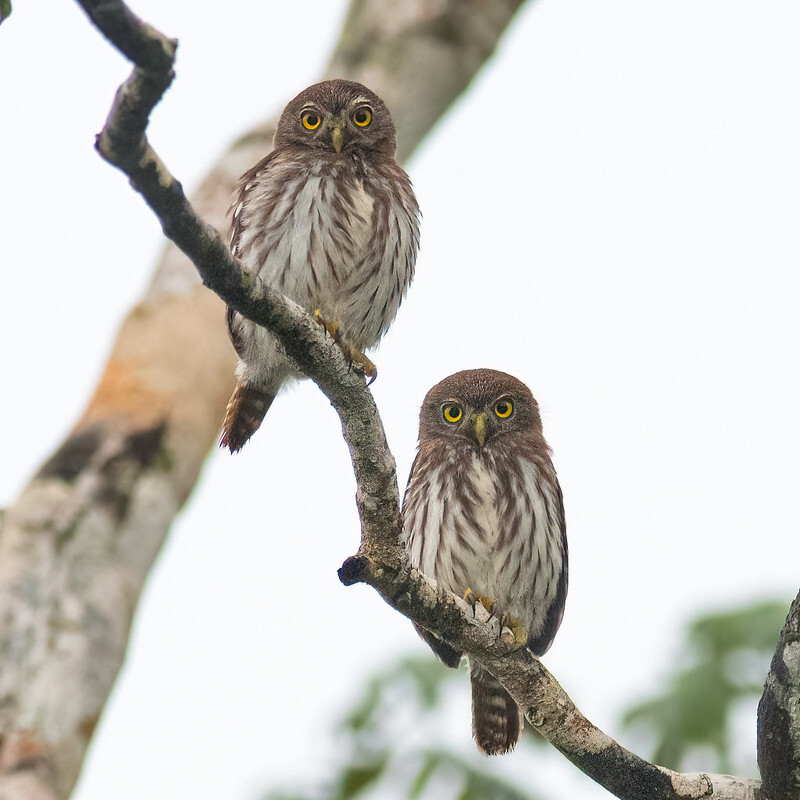
Ferruginous Pygmy-Owl (Glaucidium brasilianum) by Daniel J. Field.
On the third day of the trip (which was probably our favourite) we went into the Quintana Roo state, looking for a more humid and higher forest. As we arrived to the area where we were going to bird, we heard our first Mayan Antthrush, followed by some of the greatest looks of a male Barred Antshrike. As we kept driving, making stops and walking, we came across around 53 species. Some of the highlights for that first stop include: Wedge-tailed Sabrewing, Swallow-tailed Kite, Gartered Trogon, Keel-billed Toucan, Chestnut-colored Woodpecker, Ruddy Woodcreeper, Tawny-winged Woodcreeper, Stub-tailed Spadebill, Northern Bentbill, Yucatan Flycatcher, Lesser Greenlet, Long-billed Gnatwren, Yellow-throated Euphonia, Green-backed Sparrow, Rose-throated Tanager, Red-throated Ant-Tanager and Gray-headed Tanager.
Long-billed Gnatwren (Ramphocaenus melanurus).
From that point, we thought that we already had a very successful morning, I mean, we saw and photographed a Spadebill, a Gnatwren, an Antshrike, sometimes you don’t even get to see any of those! But, we said, okay, lets get deeper into the trail, pay our fees to help the community and do some more birding before heading to our next stop. Well, guess what, our best bird photography was ahead of us. As we got to the small camp of the community, birds were as active as can be, building nests, bringing food to their chicks, hunting butterflies, you name it. We just sat and waited and birds were sitting right in front of our cameras. Some of the birds that showed up for us at the camp included: Black-crowned Tityra, Rose-throated Becard, Yellow-olive Flycatcher, Yellow-bellied Elaenia, Boat-billed Flycatcher, Social Flycatcher, Sulphur-bellied Flycatcher, Piratic Flycatcher, Yellow-green Vireo, Yellow-throated Euphonia, Blue-gray Tanager and Red-legged Honeycreeper.
Red-legged Honeycreeper (Cyanerpes cyaneus).
We couldn’t be any happier after that morning, so we started heading south to Bacalar to relax and rest for a little bit. We stayed in Bacalar B7 Blue apartments, right in front of the lagoon, the view was great and we had a Limpkin looking for food right next to the dock at the hotel.
We went for a little walk in the afternoon, and although the main reason why we stayed in Bacalar was because that would make a shorter drive for our next birding stop the next day, we actually came across some nice birds. Highlights include: Plain Chachalaca, Red-billed Pigeon, Vaux’s Swift, Gartered Trogon, Black-crowned Tityra, Bright-rumped Attila, Sulphur-bellied Flycatcher, Lesser Greenlet, Brown Jay, Purple Martin, Spot-breasted Wren and Morelet’s Seedeater.
The next day, we left Bacalar really early and drove all the way to the Calakmul area. As soon as we got to the entrance to pay our fees, we heard some Laughing Falcons and got to see some Hooded Orioles hanging around. Our main goal that day, was to see the Ocellated Turkey, one of the two species of Turkeys in the world, this one, endemic to the Yucatan Peninsula. We started driving slowly looking for birds, and a HUGE flock of parrots made us stop. Most of them, White-fronted Parrots, but actually a pair of Red-lored Parrots went across and also, some Olive-throated Parakeets. It was a very busy day in the area, even though we got there really early, there were already lots of tourist in the area. Nonetheless, we still managed to find the Turkeys and get nice shots of them. While we were on the look for Turkeys on the road that takes you to the Archaeological Site, we also spotted some other really nice birds, including: Ruddy Quail-Dove, Black-headed Trogon, Collared Forest-Falcon, Green-backed Sparrow, Wedge-tailed Sabrewing, Ruddy Woodcreeper, Ivory-billed Woodcreeper, Mangrove Vireo, Lesser Greenlet and Yucatan Jay.
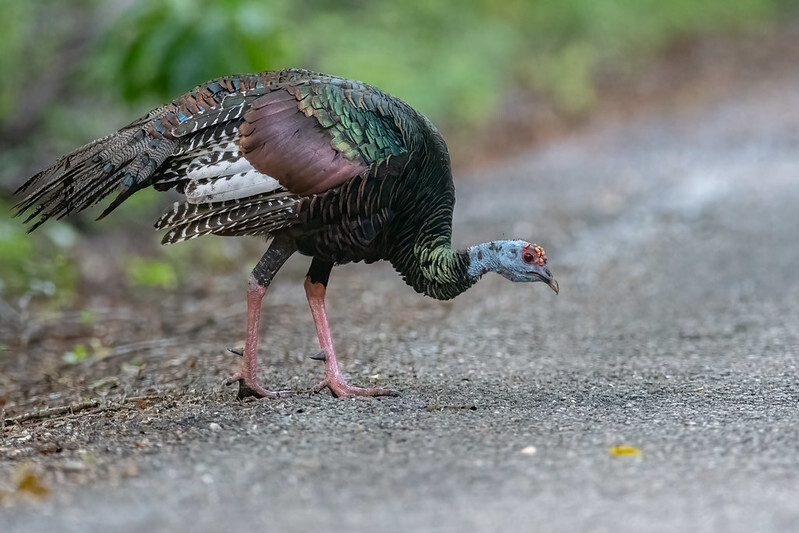
Ocellated Turkey (Meleagris ocellata) by Daniel J. Field.
Then, we got to the Archaeological Site, were we started walking, not only looking for birds but also admiring the incredible ruins in the area. As we were moving around, we came across a Pale-billed Woodpecker building a nest, some Bat Falcons feeding on top of a dead tree and then we went to the top of the highest ruins in the site, there, we spotted a Double-toothed Kite soaring. Suddenly, we started hearing a very loud Mayan Antthrush singing, so we decided to go down and try to see it, we did, but not before something really special happened, at the same moment we were trying for that Antthrush, I heard something moving on the ground, it was a pair of Singing Quails! I was astonished by the fact that those two birds were just feeding right next to us on the trail and they didn’t even payed attention to us! That literally made my day.
Although the Singing Quails were probably the highlight of the whole trip for me, we had some really cool stuff in the Calakmul Archaeological Site, some of our top birds included: Pheasant Cuckoo, Squirrel Cuckoo, Wedge-tailed Sabrewing, White-bellied Emerald, Russet-naped Wood-Rail, Keel-billed Toucan, Northern Bentbill, Eye-ringed Flatbill, White-bellied Wren, Scrub Euphonia, Yellow-throated Euphonia, Green-backed Sparrow.
Singing Quail (Dactylortyx thoracicus) at the Calakmul Archaeological Site.
On the way back, we made a stop for Royal Flycatcher and it didn’t disappoint as we found one carrying some food.
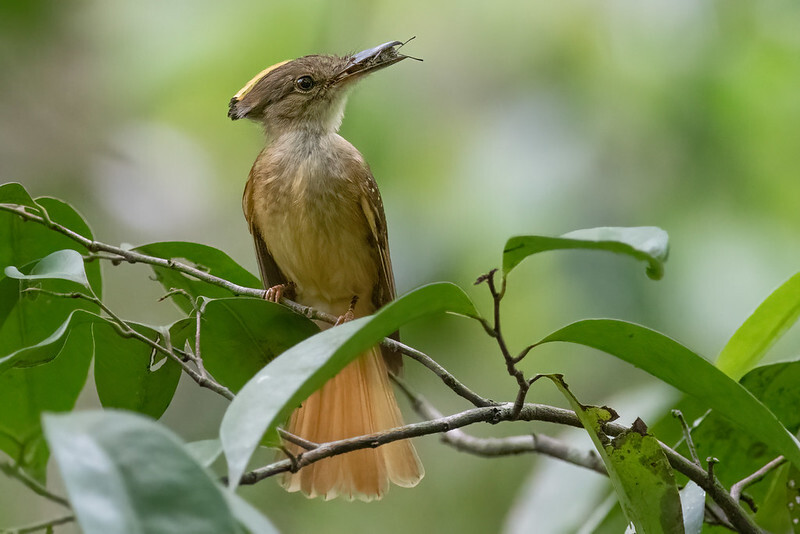
Royal Flycatcher (Onychorhynchus coronatus) by Daniel J. Field.
After a great morning birding, we went for lunch and rest at our hotel and then, we went birding around the property. Our main goal for the afternoon was to spot the Yellow-lored Parrots, as in my experience, those tricky guys, go the their roosting areas in the afternoon, so if you walk around there at that time of the day, you might as well see them in flight and might be able to get some cool shots (spoiler alert: we did). Some other nice birds from our walk around the hotel grounds in the afternoon include: Plain Chachalaca, Red-billed Pigeon, Green-breasted Mango, Turquoise-browed Motmot, Yucatan Woodpecker, Yellow-lored Parrot, Olive-throated Parakeet, Sulphur-bellied Flycatcher, Piratic Flycatcher, Yellow-green Vireo, Brown Jay, Green Jay, Clay-colored Thrush, Hooded Oriole, Blue-gray Tanager, Black-headed Saltator and Cinnamon-bellied Saltator.
The next day, we went to visit another archaeological site in the Calakmul Area. One I really like to visit everytime I go to Calakmul because most of the times, you don’t see anyone else in there. Our plan was to do a couple hours of birding as we had a long day ahead of us heading north to prepare for our last day, and although we didn’t spend as much time birding as we did the other days, we came across some really good birds like: Collared Aracari, Yellow-olive Flycatcher, Green Jay, Scaled Pigeon, Wedge-tailed Sabrewing, Eye-ringed Flatbill, Northern Beardless-Tyrannulet, Greenish Elaenia, Boat-billed Flycatcher, Carolina Wren, Red-legged Honeycreeper, Roadside Hawk, Bat Falcon, Smoky-brown Woodpecker, Red-capped Manakin, Royal Flycatcher, Stub-tailed Spadebill, Green-backed Sparrow, Red-throated Ant-Tanager, Gray-throated Chat and Blue Bunting.
Red-capped Manakin (Ceratopipra mentalis).
We got back to the hotel and we were supposed to have breakfast and rest for a little bit before hitting the road, but birds were active and we couldn’t say no to Yellow-winged Tanager, Blue-gray Tanager, Sulphur-bellied Flycatcher and Yellow-green Vireo posing for pictures.
Yellow-winged Tanager (Thraupis abbas).
After a nice breakfast and a little break, we started driving all the way back to Valladolid, which wasn’t a short drive, but it was quite an enjoyable one, as we were listening to some jams on the way.
As we were getting closer to Valladolid, we decided to stop for a little birding, we were looking for a Lesser Roadrunner, and although we didn’t see one in the whole trip, we were able to get some shots of Yucatan Jays, Yellow-tailed Oriole and Ladder-backed Woodpecker.
The next day (our last one) we left as early as possible and headed to Cozumel Island, to try and get the two endemic species plus all of the island specialties. So after arriving to the island and spending about two and half hours birding we saw: White-crowned Pigeon, Caribbean Dove, Lesser Nighthawk, Green-breasted Mango, Cozumel Emerald, Yucatan Woodpecker, Caribbean Elaenia, Cozumel Vireo, Yucatan Vireo, Blue-gray Gnatcatcher, Black Catbird, Western Spindalis, Yellow Warbler (Golden), Bananaquit and Yellow-faced Grassquit.
White-crowned Pigeon (Patagioenas leucocephala).
Cozumel Island was our last stop for birding, after that we went back to the mainland and we drove all the way to the Cancun International Airport for the end of the trip.
We finished up the trip with around 200 bird species seen and heard.
Mammal highlights: Yucatan Gray Squirrel, Geoffroy’s Spider Monkey, White-nosed Coati, Gray Fox.
Reptile Highlights: Yucatan Whiptail, Rainbow Ameiva, Brown Basilisk, Black Spiny-tailed Iguana, Yellow-spotted Spiny Lizard, Brown Anole.
Written by Luis Trinchan Guerra




